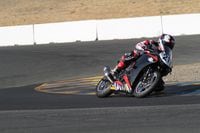Photo: Oxymoron Photography
I enjoy racing because it offers the opportunity to push myself to the limit, and provides a thrill like no other. I’ve raced 600s, and they're exhilarating. But after a race weekend I often find myself physically and emotionally exhausted. My bank account takes a beating, too.
For me, some of the thrill of racing a 600 stems from fear. I’m not naive enough to disregard the risks of tearing around on a 115-horsepower motorcycle, surrounded by guys who are willing to take crazy risks to get to the front of the pack. The intensity can be a little obnoxious at times. In club racing, 600 Production is regularly referred to as “600 Destruction” due to the frequent crashes and red flags. To date, my best finish in the class wasn’t thanks to my skillful riding, but because so many riders in front of me crashed out!
Developing the CBR into a roadracer was a long process. The first time I took it out, I came it last. Twice! We've made improvement, though, and the Honda took its first win at Fontana. Photo by Cali Photography.
But once you’ve experienced the high that comes when the green flag drops, nothing else can satisfy you. I feel fortunate, then, that I discovered 250 racing, which fulfills my need to race, but with less risk of personal injury and a lot less of an impact on my finances. People in the 250 classes tend to have a more laid back approach to racing, since they’re participating for enjoyment, and not because they intend to be the next Valentino.
If you tatter the pages of Motorcycist as much as I did before I started working here (we still read each issue a half-dozen times in digital form before it goes to print), then you know that my latest long-termer is a CBR250R. I've derived a lot of pleasure from developing the bike into a roadracer, and have raced it all over California.
With the economy in the gutter, the 250 classes have some of the largest grids going, and it’s not just because tires last forever and the bikes sip gas. People may get involved in the class because it’s affordable, but the fun is what makes them stick around. And when I say fun, I mean bounce-house fun, not planking on a fourth floor balcony fun.
The first stage of the Honda's development included the usual exhaust and intake mods. Later on we delved into the engine, increasing compression, degreeing the cams, and altering ignition timing via a custom Power Commander V.
What’s most wonderful about racing a 250 is that it’s every bit as exhilarating as racing a bigger bike, but none of the excitement comes from fear. Rather than having my stomach tied in a knot and my heartbeat pounding in my ears at the start, I’m smiling to myself and downright excited to see the flagman’s elbow twitch. On a 250 you still have to brake as late and hard as possible, carry as much corner speed as possible, and out-ride the other guys, but the speeds are significantly lower (rarely over 100 mph), which gives you plenty of time to plan and strategize, more time to recover from mistakes, and more time to enjoy the experience. There’s no horsepower to hide behind, either, so mistakes are costly and clicking off a good lap requires discipline, precision, and commitment.
I’ve really enjoyed flogging the CBR, and found that the 250 classes offer everything I want from roadracing: Tough competition and tight racing, but with mutual respect and reduced risks and costs compared to racing a 600. And the people are great. Nobody takes themselves too seriously on a 250, so egos never get in the way of the fun.
I may still race a “big bike” from time to time, but I’ve found that the CBR250 is all the racebike I really need.














/cloudfront-us-east-1.images.arcpublishing.com/octane/GTCXACQGJ5HAPDTGWUQKDEH44E.jpg)
/cloudfront-us-east-1.images.arcpublishing.com/octane/S35YGSEMEZB4BLTDJTSZPF4GLA.jpg)
/cloudfront-us-east-1.images.arcpublishing.com/octane/5UOT6HPX2JFMRJAX6EH45AR4MQ.jpg)
/cloudfront-us-east-1.images.arcpublishing.com/octane/OKWOJWAKP5EP3OACCRRWPCIX2Q.jpg)
/cloudfront-us-east-1.images.arcpublishing.com/octane/2WF3SCE3NFBQXLDNJM7KMXA45E.jpg)
/cloudfront-us-east-1.images.arcpublishing.com/octane/G4MG6OUCJNBSHIS2MVVOTPX65E.jpg)
/cloudfront-us-east-1.images.arcpublishing.com/octane/IIGGWFOTOJGB7DB6DGBXCCMTDY.jpg)
/cloudfront-us-east-1.images.arcpublishing.com/octane/QSTCM6AVEZA5JJBUXNIQ3DSOF4.jpg)
/cloudfront-us-east-1.images.arcpublishing.com/octane/U4I7G625B5DMLF2DVIJDFZVV6M.jpg)
/cloudfront-us-east-1.images.arcpublishing.com/octane/B6XD6LS6IVCQPIU6HXDJSM3FHY.jpg)
/cloudfront-us-east-1.images.arcpublishing.com/octane/ICL63FEDDRDTTMINYICCEYGMDA.jpg)
/cloudfront-us-east-1.images.arcpublishing.com/octane/FCGZHQXRBZFLBAPC5SDIQLVF4I.jpg)
/cloudfront-us-east-1.images.arcpublishing.com/octane/WNOB6LDOIFFHJKPSVIWDYUGOPM.jpg)

/cloudfront-us-east-1.images.arcpublishing.com/octane/X33NU3E525ECRHXLNUJN2FTRKI.jpg)
/cloudfront-us-east-1.images.arcpublishing.com/octane/6KKT5NNL2JAVBOXMZYS5ZO76YA.jpg)
/cloudfront-us-east-1.images.arcpublishing.com/octane/J5RKG5O455GMPGQRF2OG6LRT7A.jpg)
/cloudfront-us-east-1.images.arcpublishing.com/octane/GX2CIZKQVRH2TATDM26KFG2DAE.jpg)
/cloudfront-us-east-1.images.arcpublishing.com/octane/ZWIDYSAKQZHD5BHREMQILXJCGM.jpg)
/cloudfront-us-east-1.images.arcpublishing.com/octane/CYUHJZCTSJCH3MRAQEIKXK7SCQ.jpg)
/cloudfront-us-east-1.images.arcpublishing.com/octane/LKOFINY56FCXJCANJ5M7ZDQUBY.jpg)
/cloudfront-us-east-1.images.arcpublishing.com/octane/4NBPDACMWJH63JQYJVK3QRBDZI.jpg)
/cloudfront-us-east-1.images.arcpublishing.com/octane/KKHQHRR3FJGX7H2IPU6RALMWG4.jpg)
